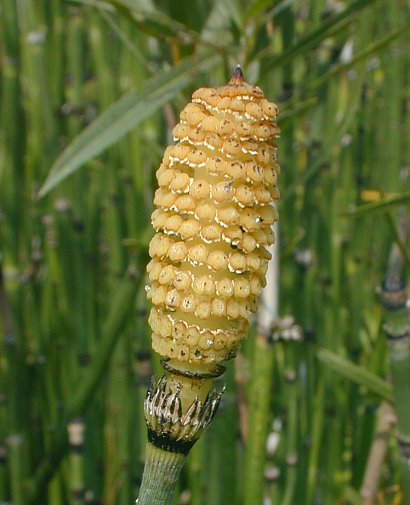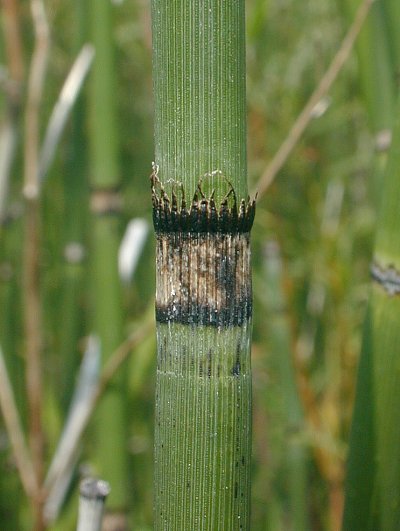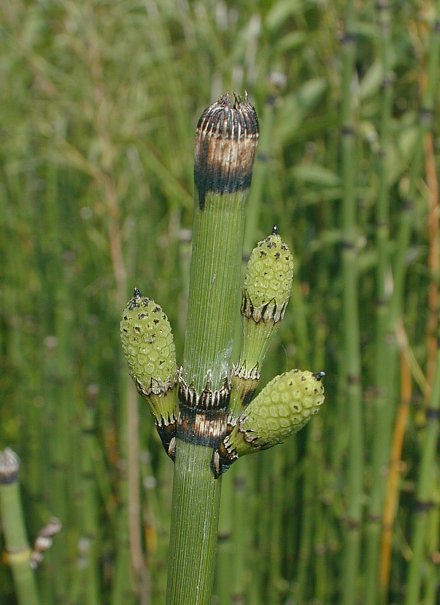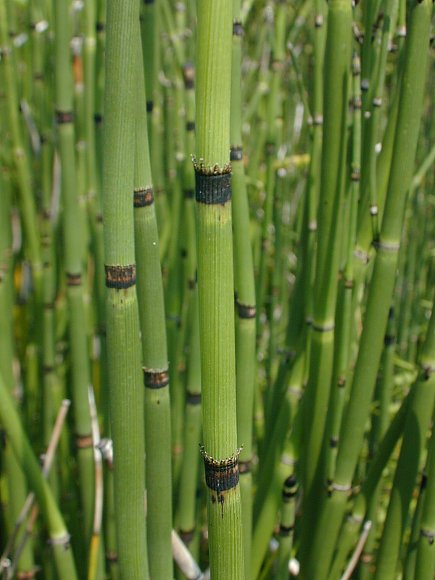Description: This perennial plant is 2-5' tall, producing both fertile and infertile shoots. Each shoot has a single central stem that is jointed, unbranched, more or less erect, and ¼–¾" (6-18 mm.) across. The central stem is medium green, olive-green, or dark green, rough in texture, and evergreen. The individual joints that make up the central stem are up to several inches long; the upper joints are usually shorter than the lower joints. The stem joints have about 15-40 fine longitudinal ridges. At the conjunctions of adjacent joints, there are appressed ring-like sheaths up to ¾" long. Except along their upper and lower rims, the sheaths are whitish grey, brown, or black. The lower rims of these sheaths are usually black, while their upper rims have 15-40 tiny black teeth (scale-like leaves). These teeth are semi-deciduous and they often break off the sheaths with age.

The interior cavity of the central stem is quite large, spanning at least two-thirds of its diameter. The central stem of each fertile shoot terminates in a spore-bearing cone up to 2" long on a short stalk. This cone is ovoid to broadly ellipsoid in shape, and it has a short narrow point at its apex. The cone is densely covered with rows of spore-bearing tubercles; it is usually pale yellow or pale reddish yellow. Instead of a single terminal cone, sometimes an older shoot will produce 1-4 spore-bearing cones on short lateral stalks just below its terminal joint. Infertile shoots are very similar to fertile shoots, except they lack spore-bearing cones. The cones release their spores from late spring to mid-summer; they wither away later in the year. The root system consists of extensive rhizomes with fibrous secondary roots. This plant often forms dense colonies; sometimes these colonies can be quite large in size.

Cultivation:
The
preference is full sun, wet to moist conditions, and soil that is
mucky, gravelly, or sandy. However, drier conditions and other kinds of
soil are tolerated. This plant can spread aggressively, especially in
locations where the soil is poorly drained. It has few problems with
pests and disease organisms.
Range & Habitat:
Scouring Rush is a common plant that occurs in every county of Illinois
(see Distribution
Map),
where it is native. This plant is widely distributed in both North
America and Eurasia; the typical variety or subspecies occurs in
Eurasia. Habitats include sand dunes, swales in black soil prairies and
sand prairies, degraded railroad prairies, low-lying areas along rivers
and ponds, marshes, seeps in open wooded areas, roadside ditches,
pastures, and gravelly railroad embankments (including the gravel
ballast). This plant is usually found in degraded habitats and less
often in higher quality natural areas.

Faunal
Associations:
Insects that feed on horsetails (Equisetum
spp.) include a flea beetle (Hippuriphila canadensis),
larvae of the Horsetail Weevil (Grypus
equiseti), and larvae of some sawflies (Dolerus apricus, Dolerus tibialis conjugatus).
The larvae of the weevil and sawflies feed on the stems. Because the
tough stems of Scouring
Rush have coarse fibers and silica deposits, they are usually avoided
by mammalian herbivores. Because of its tall stems and tendency to form
dense colonies, Scouring Rush provides excellent cover for various
kinds of wildlife,
including wetland birds, small mammals, reptiles, amphibians, and
insects.
Photographic Location:
A low-lying area along a pond in Champaign, Illinois, and a drainage
ditch near the Windsor Road Prairie of the same city.

Comments: This is the largest horsetail in Illinois; it is somewhat unusual in having evergreen stems. I am always impressed by the large dense colonies that are often formed by the stems of this plant. These tough stems were used to scour pots, pans, and floors during pioneer days, hence the common name. In spite of this common name, the Scouring Rush (Equisetum hyemale affine) is not a rush, but a horsetail. The horsetails are closely related to ferns and both were common during the Carboniferous period (280-345 million years ago), when tree-sized horsetails and ferns occurred. The coal deposits of Illinois were formed in large part from the ancestral plants of today's horsetails and ferns.

At the present time, only Equisetum hyemale affine is recognized for North America. However, some local populations of the Scouring Rush resemble Equisetum hyemale robustum (or Equisetum robustum), which was recognized as native to this continent in the past. This latter variety (or species) is more tall and stout than Equisetum hyemale affine, and the teeth of its sheaths are supposed to be more persistent. The Scouring Rush can be distinguished from other horsetails (Equisetum spp.) in the state by its large size, rough unbranched stems, and pointed cones. Usually this species is easy to identify, although sometimes it forms sterile hybrids with other horsetails. When this occurs, it is possible to confuse the hybrid with one of the parent species. As a general rule, such hybrids are less evergreen than the Scouring Rush and they are smaller in size.